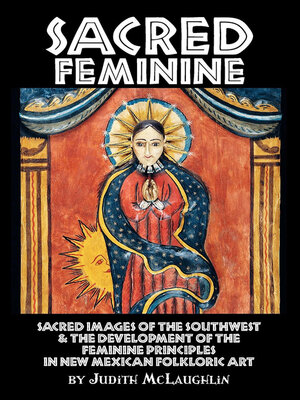
Sign up to save your library
With an OverDrive account, you can save your favorite libraries for at-a-glance information about availability. Find out more about OverDrive accounts.
Find this title in Libby, the library reading app by OverDrive.



Search for a digital library with this title
Title found at these libraries:
| Loading... |
This book examines the role of culture, religion, psychology, art, gender and history in the development of the New Mexican religious folk art form during the Colonial and Territorial Periods. It was an art that richly portrayed the feminine both in character and in spirit. From the time of the conquest in the mid-1500s, the territory was Spanish Catholic in tradition, laws, art and culture. In what was an isolated and barren land the settlers turned to their religion and eventually created a native, indigenous folk art that exemplified their faith and eased their loneliness and seclusion. The saints, carved and painted, became members of the family. Santos were the object of prayer. These saints held special places of honor in each Hispanic home usually upon an altar available for daily veneration. The saints preserved not only the faith but la famila.
During the Spanish Colonial and Territorial Periods in New Mexico, the Spanish colonists, or vecinos, lived in remote and isolated areas that were not easily accessible to the outside world. To help preserve their faith and community; religious artists, Santeros, developed an indigenous sacred folk art for the church and family. Santos, saints, were the pious expressions created by the Santeros, to help sustain the colonists spiritually and psychologically in a hostile land. The Santos inspired the faithful to connect with their spiritual and cultural heritage and helped ease their isolation and lack of contact with their homeland and traditions.
The Santos, carved or painted, by pious Santeros became members of the family. The Santo was the object of daily prayer and each family celebration or community event. These saints held special places of honor in each Catholic household usually upon an altar provided for veneration. The saints preserved not only the faith but, la famila, the family. The settlers were held together by their community and religion and only through faith, a connection to the land and sacred aspects of life were they able to endure.
Sacred Feminine examines the role that culture, religion, sociology, art and gender played in the development of the religious Santero art, in particular, the images of women. Santero art beautifully portrayed the feminine both in nature and spirit. The Spanish loved the Virgin profoundly and fervently from the 12th century onward, within the Cult of Mary, in Spain and throughout Europe. This devotion reached its peak just before and during the discovery and conquest of the New World.
From the time of the settlement and colonization of New Mexico in the late-1500s, the territory was Spanish Catholic in tradition, laws, art and culture. Therefore, the role that The Blessed Mother and female saints played in New Mexican artwork was significant. The female images fulfilled a function not only in the religious practices but within the culture of Spanish Catholic New Mexico. Their roles in art and liturgy gave women a model, or ideal, of the perfect woman and motherhood. The saints were, and are, admired and glorified in these roles.
The vecinos of New Mexico tolerated a harsh climate, isolation, poverty and separation for over 250 years before Anglo-American settlers entered the region. They had a history of utilizing their spirituality and creativity to help them withstand the circumstances they endured daily. This tradition of making iconic religious art was a work of faith, tied to the sacredness of the land and their surroundings. The images of women that were significant in this period are the focus of Sacred Feminine.






